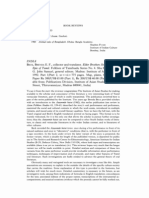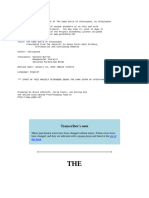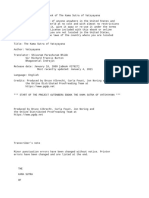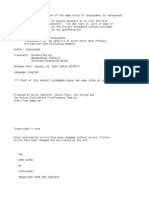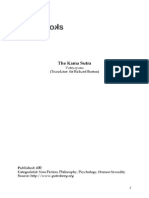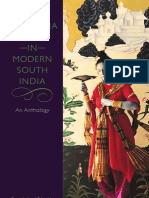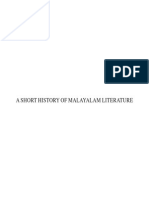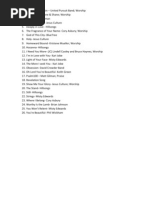A Flowering Tree and Other Oral Tales From India
A Flowering Tree and Other Oral Tales From India
Uploaded by
Harish Kumar MCopyright:
Available Formats
A Flowering Tree and Other Oral Tales From India
A Flowering Tree and Other Oral Tales From India
Uploaded by
Harish Kumar MOriginal Description:
Original Title
Copyright
Available Formats
Share this document
Did you find this document useful?
Is this content inappropriate?
Copyright:
Available Formats
A Flowering Tree and Other Oral Tales From India
A Flowering Tree and Other Oral Tales From India
Uploaded by
Harish Kumar MCopyright:
Available Formats
BOOK REVIEWS
175
often taken for granted.
Let us congratulate the scholarly team for their excellent work.
RE FE RE N C E S C IT E D
B l a c k b u r n , Stuart H .
1988 Singing o f birth and death: Texts in performance. Philadelphia: University of
Pennsylvania Press.
B l a c k b u r n , Stuart H ., Peter J. C la u s , Joyce S. F l u e c k ig e r and Susan W a d l e y , eds.
1989 Oral epics in India. Berkeley: University o f California Press.
C l a u s , Peter J.
1978 Heroes and heroines in the conceptual framework of Tulu culture. Journal o f
1991
Indian Fol\loristics 1(2): 2742.
K in songs. In Gender, genre and power in South Asian expressive traditions, eds. A.
Appadurai, F. J. Korom and M. Mills, 13677. Delhi: M. Banarsidass.
H e d a Ja s o n
Jerusalem
RAMANUJAN, A . K. A Flowering Tree and Other Oral Tales from India.
Berkeley: University o f California Press, 1997. xv + 270 pages. Glossary,
bibliography, list o f tellers and collectors, list o f tales. Cloth US$48.00;
ISB N 0-520-20398-4. Paper US$17.95; ISB N 0-520-20399-2.
This book, published posthumously and edited by Stuart Blackburn and Alan Dundes, is a
collection of Kannada folktales, collected by A. K. Ramanujan and some other scholars from
both published and oral sources. Kannada is one of the four major Dravidian languages spo
ken in Karnataka in South India. D uring the past two decades folktales from Karnataka have
been extensively collected and published in the Kannada language. There are very few col
lections, if any, in English. R am anujans nice collection is, therefore, timely and welcome.
Although some o f the tales in the present work have parallels in other Indian languages
and even other countries, all of the seventy-seven tales listed in this work have been collected
in Karnataka. Therefore, the title of the book is somewhat of a 'misnomer because it includes
no tales from any other region of India. The tales in this book were mainly collected in north
ern and southern parts o f Karnataka from Kannada sources, either directly collected from
Kannada speaking narrators or from already published texts. N o folktales from other com
munities who speak Konkani, Tulu, Kodagu etc. are included. So strictly speaking, this vol
ume is neither a representative collection of folktales of India, nor of Karnataka. But it still is
a good collection o f folktales.
Most of the tales Ram anujan did not collect himself but took from earlier published
works on Kannada folktales in the Kannada language. However, he seems to have translated
all these into English himself. Being a skilled translator, he has excelled in this task. Some of
the published works he used are as follows: J. S. Paramasiviah, Da^shina Karnataka Janapada
Kathegalu (Folktales of South Karnataka; 1977), Simpi N inganna, Uttara Karnataka
Janapada Kathegalu (Folktales of Northern Karnataka; 1988)H . J. Lakkappa Gowda,
Janapada Kathavali (Folk Narrative; 1971), Ragau, Karnataka Janapada Kathegalu (Folktales
of Karnataka; 1969)
Dhavalasri, Janapada Kathamsta (Folk Narrative; 1968)
Dr. Lingavva,
Padinelalu (Shadow; 1971). Interestingly, some o f the tales included in this volume have also
appeared in an earlier collection of the author namely, the Folktales fro m India (New York:
Pantheon, 1991).
176
BOOK REVIEWS
The arrangement of these folktales is not guided by any definite scheme o f classifica
tion. Maybe Ram anujan intended to classify these tales according to themes or some other
means, but the editors preferred to leave them as they were arranged by the collector. That
Ram anujan had some kind of classification in m ind is evidenced by his choice of opening this
collection with the interesting tale A Story and a Song a story about why stories should
be to ld .1 his way Ram anujan achieves two objectives besides presenting an interesting folk
tale: he emphasizes the importance o f storytelling and also makes his point about the role
meta-folklore plays in storytelling. Narration o f folktales, besides providing entertainment, is
a need guided by the context, the purpose, and the message it communicates. In the absence
of a purpose and message, tale narration becomes a mechanical and wasteful exercise. This is
the message o f the last tale, A Story to E n d all Stories (AT 2301 A), with which Ram anujan
chose to conclude this volume.
At the end, a partial List of Tellers and Collectors is given, which includes for at least
some tales the sex, age, and caste of the narrators, the region where a tale was found, and the
year it was collected. A large number o f tales have been left out o f this scheme. There are,
however, some tales which are shown as collected by A K R (i.e., A. K. Ram anujan) with or
without a question mark (?). This question mark not only indicates uncertainty but also cre
ates it when information is presented in the following manner:
AKR: Kambar M S or A K R (?) Kurbetii M S
This kind o f information is very confusing. One wonders if the real collector is Ram anujan
or if he has borrowed it from Kambar or whether both he and Kam bar collected it together.
Some introductory details o f these manuscripts even in the form o f brief annotations could
have helped to reduce this uncertainty, which seems to be a common trait o f almost all books
published posthumously.
Furthermore, this List of Tellers and Collectors
however incomplete it might look,
reveals that almost all these tales have been collected from Brahmin and upper caste H in d u
informants. Ram anujan himself belonged to a Brahmin family. This elite affiliation witting
ly or unwittingly has, it seems, overshadowed this collection, which even the editors acknowl
edge (xiv). It would have been interesting and academically highly rewarding if Ram anujan
had collected some tales from other nonprestigious castes or included some versions of tales
from those castes.
We learn that Ram anujan wanted to add folkloristic notes to these tales so that this col
lection could become more scholarly and also pedagogically useful. Unfortunately, however,
due to his sad and untimely demise, he could not complete these notes for many tales in this
collection. In the notes he was able to make for thirty-six tales o f the collection, Ram anujan
attempts to identify motifs and tale types, often comparing them with European tales; in the
notes he also gives reasons for the validity o f his comparisons. The editors have done an excel
lent job by adding tale type and m otif identification wherever A K R had not provided them
or where they believed another identification is possible. (227). Rarely does Ram anujan
compare the important characteristics found in this collection with the narrative repertoire
from other regions o f India. And when he does compare his data with other Indian narratives,
he confines his comparisons to written epics and narrative traditions such as Ramayana,
Pancatantra, Kathasaritsagara, and Jataka. Despite these small weaknesses in this volume, I
find these notes and comparisons scholarly and enlightening, and they certainly reveal the
scholarly interests o f Ramanujan.
Stuart Blackburn and Alan Dundes wrote a preface to the book and made a bibliogra
phy, glossary, and a list o f tale types for the book based on the Aarne-Thompson Index for easy
BOOK REVIEWS
177
reference and comparisons. The bibliography has a few inconsistencies. The editors have
ignored the Kannada publications referred to by Ram anujan, most likely because these col
lections (published and unpublished) were not available to them and because o f their lack of
knowledge of the Kannada language. The bibliography also lacks uniformity in listing pub
lications with more than one editor. In some cases the names o f all the editors are listed and
in many other cases the editors chose to give only one name and then add et al.
The preface, although not without merit, does not fulfill the need of a good introduction
to this interesting collection. At most, it is a kind of tribute academic tribute to a scholarfriend. Both Alan Dundes and Stuart Blackburn have researched Indian folklore and pub
lished books on the subject. They thus may have been able to write a good introduction to
this volume that would have made the hook academically more rewarding both for scholars
and students o f folkloristics; a good introduction would have also been a m uch better tribute
to A. K. Ram anujan than the preface. It is interesting to compare Richard Dorsons and
R am anujans situations: when Richard Dorson died (incidentally, under circumstances sim
ilar to R am anujans death), leaving incomplete the last volume of Chicago Universitys Series
on Folktales o f the W orld {Folktales o f India by Beck, Claus, Goswami, H andoo, 1986)
Ram anujan did write an introduction to the book. In short, it is sad that Ram anujans book
has no introduction as it surely deserves one.
In conclusion, then, this collection of Kannada folktales is an important collection in
the sense that it is perhaps the last book written by this important scholar. That this volume
in its present form will serve the needs o f folktale research in Karnataka or elsewhere in India
is highly doubtful. However, it is almost certain that lovers of folktales will enjoy reading this
interesting collection as they once enjoyed reading G rim m s fairy tale collections.
L alita HANDOO
Central Institute o f Indian Languages
Mysore, India
IR A N
Tarane wa taranesarayl dar Iran
(Songs and Song Writing in Iran). Tehran: Soroush Press, 1998. 572
pages. Glossary, index, bibliography, music notations. Paper Rial 19,000;
ISB N 964-435-101. (In Persian)
P a n A h I S e m n A n I, M U H A M M A D A h m a d .
This book is a voluminous and multi-layered survey on folksongs {tarane) in Iran that
includes lengthy selections of texts in various locally spoken tongues (Persian, Turkish, Dari),
as well as their translations into the standard modern Persian language.
The author at first tries to explore such fascinating subjects as the relation of folksongs
to the earliest layers of Iranian poetry, the influence o f folk poetry on high literature, and the
various regional forms o f folk poetry and rhyming and rhythmical patterns. The consequent
chapters are devoted to the various genres of Iranian folk poetry, such as childrens games, rid
dles (cistan), lullabies (lalayi), and laments for individual and communal occasions {sugvarl,
'azadan). The latter topic includes textual samples of the important S hia m ourning ritual
performance, the Ta'ziye. Further on is a discussion o f songs of merrymaking for the various
seasonal festivals, wedding, and birthing celebrations. Also discussed are work songs for var
ious agricultural activities, chants of tradesmen and street performers, songs with sociopolit
ical and historical content, and satirical ditties and love songs i^dsheqaneha) from various
regions o f the country (e.g., Azerbaijan, the South, Khurasan, Balujistan, and Mazanderan).
You might also like
- Kamasutra Vatsyayana (Pdfdrive)Document244 pagesKamasutra Vatsyayana (Pdfdrive)danmNo ratings yet
- Kama Sutra (The annotated original english translation by Sir Richard Francis Burton)From EverandKama Sutra (The annotated original english translation by Sir Richard Francis Burton)No ratings yet
- Tazkeratul Awliya by Sulaiman MakoDocument24 pagesTazkeratul Awliya by Sulaiman MakoRizwan KhanNo ratings yet
- The Kama Sutra of Vatsyayana: The Classic Burton TranslationFrom EverandThe Kama Sutra of Vatsyayana: The Classic Burton TranslationRating: 3 out of 5 stars3/5 (5)
- Liturgical Music For LentDocument11 pagesLiturgical Music For LentShirly Benedictos100% (2)
- Yds Yokdil Kelime Calismasi 2Document5 pagesYds Yokdil Kelime Calismasi 2nuray mercan100% (2)
- International Convention For The Safety of Life at Sea (SOLAS), 1974Document3 pagesInternational Convention For The Safety of Life at Sea (SOLAS), 1974Deden HabibiNo ratings yet
- A Flowering Tree and Other Oral Tales from IndiaFrom EverandA Flowering Tree and Other Oral Tales from IndiaRating: 4 out of 5 stars4/5 (5)
- The Kama Sutra of VatsyayanaDocument197 pagesThe Kama Sutra of VatsyayanaJames CagleNo ratings yet
- Vatsyayana - Kama SutraDocument142 pagesVatsyayana - Kama SutraJayadev MotamarriNo ratings yet
- A 1092Document2 pagesA 1092palanisamy1991No ratings yet
- 1560826141 the Kama Sutra of VatsyayanaDocument196 pages1560826141 the Kama Sutra of Vatsyayanaashwinee87No ratings yet
- The Kama Sutra of VatsyayanaDocument133 pagesThe Kama Sutra of VatsyayanaBojidarNo ratings yet
- KamaDocument135 pagesKamavanessacarvalho1924No ratings yet
- The Kama Sutra of Vatsyayana PDFDocument197 pagesThe Kama Sutra of Vatsyayana PDFMode Hussain Hussain modeNo ratings yet
- Meet My People 030009 MBPDocument310 pagesMeet My People 030009 MBPVisham BhimullNo ratings yet
- Blackburn - Inside The Drama-HouseDocument276 pagesBlackburn - Inside The Drama-HousevarnamalaNo ratings yet
- 7624 Rajantheran 2019 E RDocument13 pages7624 Rajantheran 2019 E RputerinadiaoctvNo ratings yet
- The Kama Sutra of Vatsyayana Translated From the Sanscrit in Seven Parts With Preface, Introduction and Concluding RemarksFrom EverandThe Kama Sutra of Vatsyayana Translated From the Sanscrit in Seven Parts With Preface, Introduction and Concluding RemarksRating: 3 out of 5 stars3/5 (119)
- The Kama Sutra of Vatsyayana by VatsyayanaDocument139 pagesThe Kama Sutra of Vatsyayana by VatsyayanaBooks67% (3)
- The Kama Sutra of Vatsyayana by VatsyayanaDocument133 pagesThe Kama Sutra of Vatsyayana by VatsyayanaCritteranneNo ratings yet
- BhāsaDocument187 pagesBhāsagamerdgreatNo ratings yet
- Vatsyayana - The Kama SutraDocument170 pagesVatsyayana - The Kama SutracoucoularacherryNo ratings yet
- Vatsyayana - The Kama SutraDocument169 pagesVatsyayana - The Kama SutrasundarsyNo ratings yet
- Dictionary of Sindhi LiteraturDocument196 pagesDictionary of Sindhi Literaturadediegog67% (3)
- Kama Sutra of VatsyayanaDocument153 pagesKama Sutra of VatsyayanaArpoxonNo ratings yet
- 793-797 Priyanka P.S. KumarDocument5 pages793-797 Priyanka P.S. KumarIngridNo ratings yet
- Rabindranath Tagore (BengaliDocument10 pagesRabindranath Tagore (BengaliSyed YasirNo ratings yet
- Karbi Folk Literature An OverviewDocument14 pagesKarbi Folk Literature An OverviewlphangchopatorNo ratings yet
- Paula Richman Ed Ramayana Stories in Modern South IndiaDocument285 pagesPaula Richman Ed Ramayana Stories in Modern South IndiaKen Mascoli100% (1)
- RAJARAO-Father Ofindian English NovelsDocument7 pagesRAJARAO-Father Ofindian English Novelsharishagb4978100% (2)
- 793-797 Priyanka P.S. KumarDocument5 pages793-797 Priyanka P.S. KumarmohneeshNo ratings yet
- PG IV Sem-Indian English FictionDocument134 pagesPG IV Sem-Indian English Fictionpavithrakathir2602No ratings yet
- A Poem at the Right Moment: Remembered Verses from Premodern South IndiaFrom EverandA Poem at the Right Moment: Remembered Verses from Premodern South IndiaNo ratings yet
- Malayalam HistoryyDocument3 pagesMalayalam HistoryyamrikesaNo ratings yet
- Kama Sutra VātsyāyanaDocument206 pagesKama Sutra Vātsyāyanarm9819828No ratings yet
- Nissim EzeikelDocument3 pagesNissim Ezeikelrohiarora895No ratings yet
- Download A Poem at the Right Moment Remembered Verses from Premodern South India Velcheru Narayana Rao (Editor) ebook All Chapters PDFDocument37 pagesDownload A Poem at the Right Moment Remembered Verses from Premodern South India Velcheru Narayana Rao (Editor) ebook All Chapters PDFmachturtizwe100% (3)
- The Kama Sutra by VatsyayanaDocument186 pagesThe Kama Sutra by Vatsyayanakhilmi 12345No ratings yet
- Candidasa - Singing The Glory of Lord Krishna - The Srikrsnakirtana - Stewart - OCRRINGDocument3 pagesCandidasa - Singing The Glory of Lord Krishna - The Srikrsnakirtana - Stewart - OCRRINGAlex WolfersNo ratings yet
- Memoirs of SaintsDocument19 pagesMemoirs of SaintsMohammed Abdul Hafeez, B.Com., Hyderabad, IndiaNo ratings yet
- BookDocument124 pagesBookagrk2000100% (1)
- KAMA SUTRA: The original english translation by Sir Richard Francis BurtonFrom EverandKAMA SUTRA: The original english translation by Sir Richard Francis BurtonRating: 3 out of 5 stars3/5 (146)
- History of Telugu LanguageDocument144 pagesHistory of Telugu Languagesrk_uk100% (7)
- Children's Literature of Bengal - Provash Ronjan DeyDocument28 pagesChildren's Literature of Bengal - Provash Ronjan DeyRupulaughs100% (1)
- Many Ramayanas: The Diversity of A Narrative Tradition in South AsiaDocument2 pagesMany Ramayanas: The Diversity of A Narrative Tradition in South Asiaविवेक भारद्वाजNo ratings yet
- the busDocument18 pagesthe busmanya tharejaNo ratings yet
- Sangam LiteratureDocument5 pagesSangam LiteratureLidwin BerchmansNo ratings yet
- Battle of PalnaduDocument3 pagesBattle of Palnadusai ganeshreddyNo ratings yet
- Playing With Japanese Songs Politics or PleasureDocument19 pagesPlaying With Japanese Songs Politics or PleasurehelenamxNo ratings yet
- Decline and Fall of Tamil Love PoetryDocument69 pagesDecline and Fall of Tamil Love PoetryRavi SoniNo ratings yet
- Reviewer in EnglishDocument4 pagesReviewer in EnglishJayson YanguasNo ratings yet
- 1 - LET Reviewer Afro-Asian Literature I. Afro-Asian Literature Terms. Encircle The Letter of The Correct AnswerDocument4 pages1 - LET Reviewer Afro-Asian Literature I. Afro-Asian Literature Terms. Encircle The Letter of The Correct AnswerLove EsmeroNo ratings yet
- Unit 1Document9 pagesUnit 1animelistic. sqNo ratings yet
- Unit 11Document12 pagesUnit 11febindieNo ratings yet
- Sahitya Akademi Indian Literature: This Content Downloaded From 132.174.255.223 On Wed, 27 Jul 2016 09:51:21 UTCDocument15 pagesSahitya Akademi Indian Literature: This Content Downloaded From 132.174.255.223 On Wed, 27 Jul 2016 09:51:21 UTCANUSMITA BHATTACHARJEENo ratings yet
- H2PowerToday1109 Design InnovatiaDocument4 pagesH2PowerToday1109 Design InnovatiaHarish Kumar MNo ratings yet
- Digital Signal ProcessingDocument2 pagesDigital Signal ProcessingHarish Kumar MNo ratings yet
- H2PToday1902 - Design - TexasInstruments - Part 8Document8 pagesH2PToday1902 - Design - TexasInstruments - Part 8Harish Kumar MNo ratings yet
- Aluminium Electrolytic Capacitor CDE - AEappGuideDocument22 pagesAluminium Electrolytic Capacitor CDE - AEappGuideHarish Kumar M100% (1)
- SSL3250A: 1. General DescriptionDocument26 pagesSSL3250A: 1. General DescriptionHarish Kumar MNo ratings yet
- Ss32 Thru Ss36: Reverse Voltage - 20 To 60 Volts Forward Current - 3.0 AmperesDocument2 pagesSs32 Thru Ss36: Reverse Voltage - 20 To 60 Volts Forward Current - 3.0 AmperesHarish Kumar MNo ratings yet
- Surface Mount Power Package: Semiconductor Technical DataDocument4 pagesSurface Mount Power Package: Semiconductor Technical DataHarish Kumar MNo ratings yet
- CC2 PDFDocument5 pagesCC2 PDFHarish Kumar MNo ratings yet
- 2 Design Lab II: An Automatic Power Factor Correction SystemDocument8 pages2 Design Lab II: An Automatic Power Factor Correction SystemHarish Kumar MNo ratings yet
- Flyback - Vin 9-36vdc, Vout 15v, - CONST FREQDocument1 pageFlyback - Vin 9-36vdc, Vout 15v, - CONST FREQHarish Kumar MNo ratings yet
- Android SDK One PagerDocument1 pageAndroid SDK One PagerHarish Kumar MNo ratings yet
- ScratchDocument17 pagesScratchrobokalamprojectsNo ratings yet
- BAD LIAR ChordsDocument2 pagesBAD LIAR ChordsMor TredNo ratings yet
- Exploiting Active RIS in NOMA Networks With Hardware ImpairmentsDocument15 pagesExploiting Active RIS in NOMA Networks With Hardware ImpairmentsOPTICALMIMOOFDMNo ratings yet
- Đề Thi Số 16: 1. A. B. C. 2. A. B. C. 3. A. B. C. 4. A. B. C. 5. A. B. CDocument8 pagesĐề Thi Số 16: 1. A. B. C. 2. A. B. C. 3. A. B. C. 4. A. B. C. 5. A. B. Cminh châu trịnhNo ratings yet
- Year 9 Autumn 1 2018Document55 pagesYear 9 Autumn 1 2018andyedwards73No ratings yet
- Gossip Girl Figured World: A Social World That Has Specific Rules and Conventions For Appropriate BehaviorDocument11 pagesGossip Girl Figured World: A Social World That Has Specific Rules and Conventions For Appropriate BehaviorJaycie FaderNo ratings yet
- Caballero de La Muerte - SoloDocument3 pagesCaballero de La Muerte - SoloRRodas BulejeNo ratings yet
- H.264 4 / 8 / 16CH 960H DVR Quick GuideDocument12 pagesH.264 4 / 8 / 16CH 960H DVR Quick GuidePaco EgNo ratings yet
- Aqa Gcse Music SpecificationDocument34 pagesAqa Gcse Music Specificationapi-228727621No ratings yet
- Bsi BS en 54-1 - 2011 - 030724554630Document22 pagesBsi BS en 54-1 - 2011 - 030724554630YasmeenAT TradingNo ratings yet
- Notion Score LibraryDocument3 pagesNotion Score LibraryNitsan MugurNo ratings yet
- Pronunciation Training WorkbookDocument18 pagesPronunciation Training WorkbookEduardo AlvaradoNo ratings yet
- Etsi TS 141 101Document24 pagesEtsi TS 141 101mozbalNo ratings yet
- Men at Work - Overkill F#Document1 pageMen at Work - Overkill F#marcela.duarte.arisaNo ratings yet
- Run RaggedDocument3 pagesRun RaggedLondon PianoNo ratings yet
- I Finally Found SomeoneDocument1 pageI Finally Found Someoneemoe77No ratings yet
- Homeward BoundDocument31 pagesHomeward BoundTammy DaoNo ratings yet
- The Chromacaster User's Manual & Guide: The Neck/Reverse ModelDocument8 pagesThe Chromacaster User's Manual & Guide: The Neck/Reverse ModelChris EfstathiouNo ratings yet
- Pioneer - DEH-P3000R Multi-Cd PDFDocument68 pagesPioneer - DEH-P3000R Multi-Cd PDFaldoNo ratings yet
- CPFPA Professor Alberto BarriosDocument24 pagesCPFPA Professor Alberto Barriosyoli GIAPNo ratings yet
- Everybody Wants To Rule The World Chords by Tears For Fearstabs at Ultimate Guitar ArchiveDocument4 pagesEverybody Wants To Rule The World Chords by Tears For Fearstabs at Ultimate Guitar ArchiveRonaldo CordeiroNo ratings yet
- La Paloma (Celino Romero)Document7 pagesLa Paloma (Celino Romero)yu3zaNo ratings yet
- La La Land Full ScriptDocument118 pagesLa La Land Full ScriptAnushka AroraNo ratings yet
- Template Nilai Akhir Mata Pelajaran Pendidikan Pancasila Dan Kewarganegaraan Kelas 11 RPL 2Document19 pagesTemplate Nilai Akhir Mata Pelajaran Pendidikan Pancasila Dan Kewarganegaraan Kelas 11 RPL 2Nuzirwan NuzirwanNo ratings yet
- Father We Commit To You - Full ScoreDocument4 pagesFather We Commit To You - Full Scorefannykalensang50% (2)
- Pet 705Document28 pagesPet 705api-3702225100% (3)
- 1 Practise-QuestionsDocument3 pages1 Practise-Questionsharsha sagarNo ratings yet












